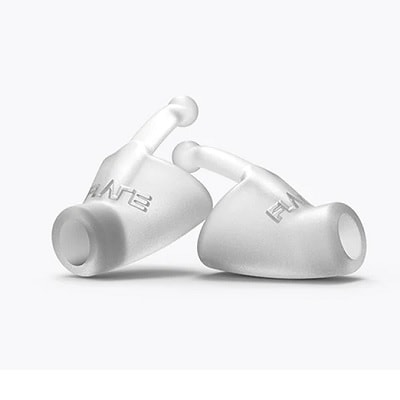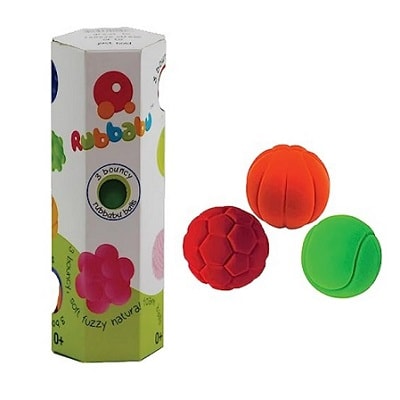How to Deal with Sensory Issues at Work
This post may contain affiliate links and Corporette® may earn commissions for purchases made through links in this post. As an Amazon Associate, I earn from qualifying purchases.

While all of us are irritated by sensory distractions at the office, like burned-popcorn smell or super-loud typing, the workplace can make some people go into sensory overload — so today we're talking about how to deal with sensory issues at work. While it's a happy accident that we're sharing this post during Disability Pride Month (we're admittedly not quite that organized), it's a great reminder to be aware of the invisible disabilities that affect millions of people.
Some of the advice and products we're featuring today — especially the tips on “sensory-supportive” work environments and employer accommodations — can help people with ADHD, autism, sensory processing disorder, migraine, misophonia, and even folks in recovery from concussion or TBI. However, this info can benefit people without a formal diagnosis or condition, too.
While neurodivergence is represented on Team Corporette (and among a couple of our family members), we also reached out to an expert. Dr. Nicole Villegas, OTD, OTR/L, founder of The Institute for Sensory Conscious™ Living in Portland, OR, answered our questions via email. Her input can help both readers with sensory issues and managers trying to accommodate their employees. (This interview has been edited for length and clarity.)
What to Know About Sensory Issues at Work
Corporette: Do you have products to recommend that can make an office more sensory-friendly?
Dr. Villegas: Although I don't currently endorse specific products, here's some guidance:
Sensory-supportive environments aren't “one size fits all,” because our personal experience shapes how we engage in the space. Keep adjustability and adaptation in mind if you're looking for products to make the office more sensory-supportive. Take vision and lighting needs, for example. The office may already have adjustable lighting features like blinds on the windows, and adding smart light bulbs to workspace lamps can make the lighting even more adaptable to individual needs.
Sometimes creating a sensory-supportive environment means removing input rather than adding to it. This can look like turning the volume down on office-wide music, or decreasing visual clutter in shared workspaces.
Employers I've worked with have been surprised to learn how much their clothing, hair, or tech-use policies prevent their employees from creating a more sensory-supportive work environment. These policies may be implicit or explicitly enforced. Consider whether rules about wearing hats, sunglasses, earplugs, and “professional” attire or hairstyles impact you or your team.
{related: executive functioning tips and tricks}
Can You Get Your Employer to Pay for Sensory-Friendly Accommodations?
Corporette: Under what conditions can someone get their employer to pay for items like these — and to make other sensory accommodations? Do you have to be diagnosed as having a disability?
Whether modifications are provided by employers through reasonable accommodations per the ADA or individual requests without a documented disability, the goal is to help overcome barriers and improve access in the workplace. This shared goal can help ground communication between the employer and the employee.
[This communication] can include a shared goal to improve your work experience and performance, an openness to consider options to address the barriers, and a willingness to problem-solve over time.
“Reasonable accommodations” are covered under the [ADA] and require a documented disability. While some of my clients successfully go through the process of requesting reasonable accommodations through ADA provisions without employer pushback, others have distressing experiences that exacerbate [their] challenges … . In my experience, employees with barriers that are not visible … are more likely to experience slower resolution to their requests.
{related: should you tell your colleagues that you're autistic?}
Corporette: What strategies do you suggest regarding requesting accommodations — for example, getting your employer to approve a hybrid or WFH arrangement for sensory-related reasons if employees are required to be at the office every day?
This is where communication and self-advocacy come in.
1. When approaching your employer, highlight your shared goals and speak to how your hybrid schedule or working from home will help you to meet those goals.
2. Acknowledge the resources that each of you have (time, funding, expertise, contributions).
3. Map out a plan that meets your needs, and include check-ins over time.
4. An occupational therapist, a coach, or legal representative who specializes in workplace accommodations or self-advocacy may be helpful resources for this process.
{related: medications and your job: business etiquette tips for going off your meds}

Some of the Best Products to Deal with Sensory Issues at Work
Our recommendations come from a few sources: The experiences of a family member who is autistic, the experiences of an autistic friend of mine, and a Facebook group for neurodivergent alums of my alma mater.
These items can help not only in an office environment (especially in an open-plan workplace!), but also in a home office, too. Please share your own recs in the comments!
Flare Calmer Earplugs

Flare's Calmer “earplug alternatives“ are recommended by many folks who are especially sensitive to certain sounds.
Made from hollow silicone for comfort (no latex, in case you're allergic), Calmer doesn't block sound but instead reduces trigger noises, e.g., traffic sounds, electronic buzzing, the sounds of people eating/chewing, commuting noises) while keeping the general environmental sounding “natural.” Flare explains, “Calmer reduces resonance (distortion) by using a tiny waveguide to reflect sound into our ear which bypasses the effect of the Concha.”
One member of the Facebook group I mentioned above said they're “total meltdown prevention” and noted, “My life is better when I have less to process, and I can certainly do better work that way!”
These earplugs are available at Amazon; if you buy them directly from Flare (£19.95), you get a 100-day return policy (and free shipping as well). The options available (in addition to Mini) are Soft, Secure, Kids, and Pro. A mesh carrying pouch is included.
Loop Engage Plus Earplugs

Loop has a thorough quiz on their website that helps you pick the right earplugs for you. Pictured is Loop Engage Plus, which reduces and filters noise up to 16 dB and “takes the edge off” sounds. The included Loop Mute accessory provides an extra 5 dB of noise reduction, and sizing is versatile, because each pair includes four interchangeable ear tip sizes.
Regarding sensory issues, the company notes, “From helping [people] tune out triggering sounds in social settings without feeling so distant to helping them focus at work, Loop earplugs help people with ADHD, autism, misophonia and more…”
Reviewers have shared comments like “As someone who is autistic and neurodivergent it makes a huge difference to be able to cut down the amount of stimuli I take in,” and “I'm Autistic and these are life changing for my sensory issues.
Loop earplugs are available at Amazon, including the Engage Plus; this model is sold at Loop Earplugs for $44.95 with 100-day free returns.
Note: With earbuds, it largely depends on the individual, and it may take some trial and error. If Calmer doesn't work for you, for example, try Loop, dBud, noise-canceling headphones, etc. — or a pricier but effective alternative, AirPods. (I don't have a particular sensitivity to sound, but I'm so impressed by their noise-canceling mode.)
Lepro Desk Lamp

If your office has harsh fluorescent lights — and you can't escape them by moving to a different office or cubicle — a desk lamp can provide more gentle lighting. Even adding a desk lamp to existing light sources can help by creating layered lighting.
Look for a lamp that offers adjustable brightness levels and different color temperatures, and play around with the settings to find the combo you like. This one from Lepro, pictured, has five dimmer levels and three color modes (and is eligible for free returns).
On the higher end (for your home office), many autistic folks (like this person) recommend Philips Hue smart lighting, which has three light ranges: soft white light, warm-to-cool white light, and white and colored light. Specific technical details, as textbook authors say, are “beyond the scope of this book,” er, blog. Check philips-hue.com for more info.)
Two additional strategies (1) Some people bothered by fluorescent lights cover them with fabric or with thin covers like these filters from Octo Lights. (Of course, you'll have to check if your employer allows this.) (2) FL-14 tinted eyeglasses (like these at Amazon) were developed to ease people's eye discomfort from fluorescent light, and often help people who are especially sensitive to light for various reasons, including migraine. (If you wear prescription glasses, ask your ophthalmologist about your options here.)
Some neurodivergent people have even noted that blue light glasses really help them with light sensitivities!
Venty Wireless Desk Fan

If you don't have the common summertime dilemma regarding your office feeling like the inside of a refrigerator, a fan can make a big difference in your comfort — and in turn, your concentration. In some of my office jobs, I ran my desk fan pretty frequently. I bought a basic model (this one, which is still going strong a decade later), while today, you can get inexpensive desk fans (like this one) that charge via USB.
If a small fan like that won't cut it (the top speed on my old one is kinda sad), I recommend the fan pictured above, which my son uses at home. Going far beyond a basic desk fan, this foldable, wireless model has a battery that lasts up to two days (and charges via USB), plus a little remote. It has four speeds (plus lights, which you can turn off) and has a maximum height of three feet. You can even charge your devices with it. At just over 2.5 pounds, it's easily portable, and it even has a travel case. Granted, it's four to five times the price of basic desk fans, but if a basic option won't cut it, here's your fan!
Note: If you want a fan to do double duty — cooling and providing white noise — it's probably better to get a cheap one that doesn't boast that it's silent.
Levoit Air Purifier

You might not think of an air purifier as something that can contribute to a sensory-supportive office environment, but certain models can not only reduce distracting odors but also generate white noise. (Note that some models promise almost zero noise.)
If you want your air purifier to go beyond improving general air quality and also tackle office odors, get one with a carbon air filter, because HEPA filters alone aren't effective at tackling smells. A pricier option is a Molekule air purifier, which uses technology called PECO (photo electrochemical oxidation) to fight odors. Unfortunately, the brand's two models are $359.99 (mini) and, ahem, $1,014.99 (full size). (Remember, no matter what product you buy, you'll have to regularly pay for replacement filters.)
A more affordable option is the pictured air purifier from Levoit. It's designed for homes with pets, but for a pet-free office, I'd certainly trust something designed for pesky pet odors. (Plus, it's earned a 4.7 out of 5.0 stars at Amazon from 99,000+ ratings!) This model has an activated carbon filter and can handle about 200 sq. ft of space — so it should be adequate for a typical office.
Fidget Objects and Toys

You have a lot of options in this category — perfect for fidgeting during video calls and so on. Proprioceptive input can really help.
Companies like Rubbabu make textured ball toys for sensory input. Rubbabu's are made (through ethical production) from 97% rubber foam, are free from fillers and chemicals, and are anti-microbial, hypoallergenic, and mildew-resistant. While they're marketed to kids, they're helpful for anyone (although admittedly, they're pricey).
The pictured assortment is available at Amazon; Rubbabu.com has a bigger assortment of balls (heh).
Other helpful fidgets are fidget cubes (my son likes them), Greek worry beads (komboloi, a classic; available at Amazon, and tons at Etsy), mesh/marble fidgets (I like them), the ubiquitous Pop-Its (satisfying!), polished stones (check your local science museum!), and spinner rings (as in rings to wear).
{related: better ergonomics at the office: what products have you tried and loved?}
More Products to Help with Sensory Overload at Work
I recently talked to the autistic friend I mentioned above, and she sent me a TON of recommendations to share with readers. She added, “Just generally making sure you know what is and is not helpful for you to help narrow the list down is key.” (Before buying an item, or requesting that your employer provide a particular product, see if you can borrow something similar from a friend or relative.) In addition to the products below, she suggested setting your laptop display to “night mode” so the colors are warmer, and if possible, working in a conference room with the lights off.
The products are almost all my friend's specific recs; we've linked to examples for the ones she didn't provide links for.
1. Gaiam acupressure mat: “also comes in a smaller mat/seat cushion, and neck pillow”
2. Octorox spiky massage balls: “good sensory input for your feet”
3. Guohaoi weighted blanket: “I have no idea if this is good or not, but it’s in my wish list.” (We've previously recommended ones from Amazon, Brookstone and Magic Weighted Blanket.)
4. Octorox Spiky Massage Balls: “good sensory input for your feet”
5. EverRest foot rest: “I cant speak to the lumbar support since I don’t have it, but this is the foot rest I use.”
6. Loft ponte pull-on pants: “[This] stretchy material is HEAVENLY.” (Note that these pants are on sale and selling out quickly, but Universal Standard offers pull-on ponte pants in three colors in a wide size range for $98.)
7. Xumbtvs coffee sleeves: “For people who don’t like wet hands but get iced coffees (but also they’re just great for anyone)”
8. ONO fidget roller: “I’ve heard good things about these fidgets.”
9. Compression clothing: “Wear compression clothing UNDER work clothes, like compression shorts under dresses, compression tanks under shirts, etc.” [ex. Athleta shorts, Girlfriend Collective tank].
10. Under-desk bike pedals, ellipticals, or treadmills [ex. Vaunn under-desk pedal]
11. Neck fans/neck heaters: “They look kind of like headphones that someone took off to rest on their neck.” [ex. AMACOOL]
{related: how to manage ADHD in the workplace}
Other Tips for Handling Sensory Issues at Work
1. This Twitter thread from 2022 has a ton of “easy, stand-alone autism hacks” that can help anyone with sensory sensitivities — for work and beyond. One example: Use detergent designed for wool (like this one) to keep your workwear (and WFH wear) feeling soft.
2. Chew gum.
3. Wear sunglasses indoors (or try blue light glasses!)
4. Use a white noise machine, white noise app, or Spotify playlist (or this constant brown noise on Spotify, which I'm using as I write this.
Readers, do you have tips to share for handling sensory issues at work (whether or not you have a related diagnosis)? What products have helped you, and how has your employer accommodated your needs, if at all?
Stock photo via Deposit Photos.

This is really interesting, thank you, from someone who isn’t neurodivergent but has multiple chemical sensitivity. MCS means migraines and breathing problems from perfumes, VOCs from new furniture/carpets/paint, artificial fragrances in hand sanitizers and cleaning products etc. It is very challenging.